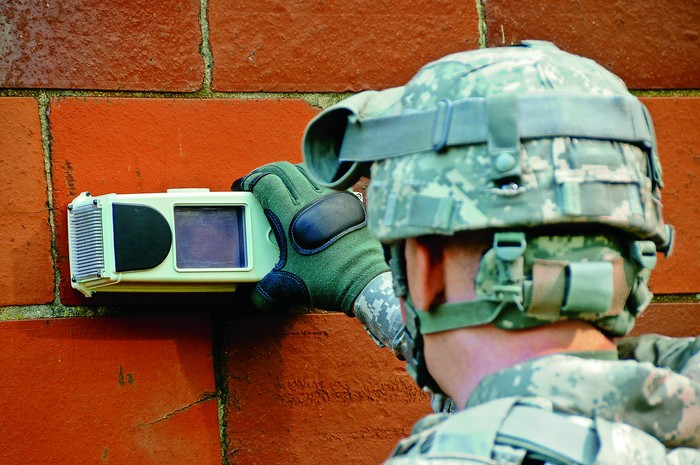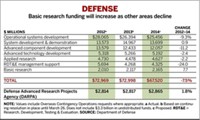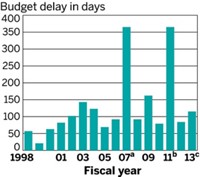Advertisement
Grab your lab coat. Let's get started
Welcome!
Welcome!
Create an account below to get 6 C&EN articles per month, receive newsletters and more - all free.
It seems this is your first time logging in online. Please enter the following information to continue.
As an ACS member you automatically get access to this site. All we need is few more details to create your reading experience.
Not you? Sign in with a different account.
Not you? Sign in with a different account.
ERROR 1
ERROR 1
ERROR 2
ERROR 2
ERROR 2
ERROR 2
ERROR 2
Password and Confirm password must match.
If you have an ACS member number, please enter it here so we can link this account to your membership. (optional)
ERROR 2
ACS values your privacy. By submitting your information, you are gaining access to C&EN and subscribing to our weekly newsletter. We use the information you provide to make your reading experience better, and we will never sell your data to third party members.
Policy
Rethinking Defense Science
A changing world means new challenges for the Department of Defense’s science and technology enterprise
by Andrea Widener
August 6, 2012
| A version of this story appeared in
Volume 90, Issue 32

David C. Morton and his team at the U.S. Army Research Laboratory faced a $4 million chemistry problem: Develop a glue that could survive the harsh conditions of semiconductor manufacturing—acids, etching, plasmas, and a vacuum—and then peel off like a Post-it note.
COVER STORY
Rethinking Defense Science
The glue anchored the creation of light, flexible displays to replace the fragile, heavy glass screens that soldiers use for everything from chemical and biological weapons detection to communications to X-ray detectors for examining potential bombs.
“The Army recognized that flexible displays were a useful technology, so we wanted to speed their development,” says Morton, who manages the Flexible Display Center at the Army’s lab in the Washington, D.C., suburb of Adelphi, Md. Developing that glue was just one step in the $94 million, 10-year project, which was run under a contract with Arizona State University with the participation of around 30 industrial partners.
The glue worked. As he shows off a flexible screen on the sleeve of a camouflage uniform, Morton estimates that the Army lab’s investment has sped development of the flexible displays by five years. “We are successful in the sense that there will be commercial technology this year that the Army will be able to buy,” he says.
That success is just the kind the Department of Defense seeks from its nearly $75 billion-per-year science and technology enterprise, which is larger than all other federal R&D programs combined. Its internal research labs and contracts with universities and industry all focus on developing the science and technology that the military will need in the future.
But DOD is facing changes now that could make designing future technologies more challenging. Shifting military goals, a decreasing overall defense budget, and the globalization of science will all alter DOD’s approaches to science and technology. The very nature of the agency’s mission—its size and bureaucracy, its need for secrecy, and its importance to the U.S.—also colors its future. Charting a path where its basic and applied research can quickly be turned into arms or aircraft or armor will, in part, define whether DOD’s R&D is successful.
“We make investments today that we want to have in place for our warfighters 15 years from now,” says Zachary J. Lemnios, who oversees DOD’s science and technology vision as assistant secretary of defense for research and engineering. “We have GPS; we have stealth; we have precision weapons; we have advanced concepts that exist today because those research efforts were put into place a dozen years ago.”
DOD’s top leadership clearly sees science and technology as vital to the military’s prospects. “We’re depending a great deal on being at the technological edge of the future,” Defense Secretary Leon E. Panetta said in February when releasing the 2013 budget. “If we’re going to deal with the kind of challenges we’re going to face, we’ve got to be smart enough, innovative enough, creative enough to be able to leap forward.”
The military is moving from waging wars alone to working in coalitions, from combat to humanitarian relief and infrastructure development, and from European missions to those in the Asia-Pacific and Middle East regions.
“We are at an inflection point,” says Robert Hummel, chief scientist at the Potomac Institute for Policy Studies and a former program manager at the Defense Advanced Research Projects Agency (DARPA), a program that seeks out and funds large-scale, potentially risky ideas. “Different missions will become priorities, and the way the military will conduct those missions will be different,” he says. That will mean a new emphasis for defense research and engineering too.
Those changes were reflected in a new set of science and technology priorities DOD released last year. Rather than laying out specific research areas, the priorities identify capabilities that DOD wants for the future, including countering weapons of mass destruction, analyzing and using data quickly and accurately, and designing new autonomous vehicles.
Meanwhile, DOD’s science funding will face cuts as the overall defense budget will likely decline. DOD’s R&D funding has been large, but it usually follows the ups and downs of overall military spending, explains Matthew Hourihan, director of the R&D Budget & Policy Program at the American Association for the Advancement of Science. DOD’s overall R&D budget has been falling since its peak of $81.2 billion in 2008, if the costs of wars are not figured in.
DOD’s 2012 budget for research, development, testing, and evaluation is $74.5 billion, down 5.8% from $79.1 billion in 2011. The majority of that goes to weapons development, rather than to what is traditionally considered research at agencies like the National Science Foundation and the National Institutes of Health. NSF and NIH rarely fund advanced development work because industry usually steps in to turn prototypes into products. But DOD’s products have a limited market, so the agency is forced to pick up the tab.
Only about $12 billion of DOD’s 2012 budget goes to early-stage science and technology programs comparable to those supported at NSF or NIH, Hourihan says. About $2 billion of that goes to basic research, which has been given priority and has held steady or risen slightly during the Obama Administration.
“Money is not the biggest challenge, even now,” says William S. Rees Jr., a chemist and leader of the agency’s basic research from 2006 to 2009. “Correct allocation of those resources remains the biggest challenge.”
Allocation is a problem because of the scale of the agency’s research endeavor: It has 67 research sites and 60,000 employees. And that doesn’t include the defense contractors, small businesses, universities, and others competing for R&D resources. “There are so many sources and so many pieces of DOD,” says C. Bruce Tarter, former director of the Department of Energy’s Lawrence Livermore National Laboratory who recently served on a Defense Science Board review of DOD’s basic science.
DOD’s R&D budget is split among the agency’s military research centers—Air Force, Army, and Navy—and the Pentagon’s research and engineering enterprise, which includes DARPA. Each of DOD’s R&D arms has its own goals and its own bureaucracy.
For example, at the Army Research Lab, the focus is on the soldier, says Cary F. Chabalowski, the lab’s associate director for plans and programs and a quantum chemist. “That is why we exist. In that way we are much more like a corporate research lab that would be within industry than a university research institute.”
Researchers funded by DOD approach problems differently than other basic scientists. Those working on basic science research problems within DOD have a specific goal in mind, which in some ways is more challenging, says Rees, who also ran global science programs at DOE’s Los Alamos National Laboratory. “You will be judged exclusively on ‘Did you solve the problem?’ ”
That problem for Army lab chemist Arthur Cresce is to create a stable 5-volt lithium battery. “We weren’t allowed to do chemistry for the sake of chemistry. We have a mission,” Cresce says. “But we certainly have leeway” to pursue interesting research offshoots within that mission.
One such tangent led Cresce and colleague Kang Xu to create an electrolyte that is more stable in the high-stress environment of a 5-V battery. Discovering the new electrolyte required fundamental research into the interface between liquids and solids in a battery. “If you are working for a company, it is very hard to put aside research time to do that, but for us it is part of the mission,” Cresce explains.
DOD’s Science And Technology Priorities
◾ Autonomy: Develop autonomous systems to augment military operations.
◾ Counter Weapons of Mass Destruction: Counter known, unknown, and emerging threats.
◾ Cyber: Improve DOD performance for all operations in cyberspace.
◾ Data-to-Decisions: Shorten the cycle time from data gathering to decisions.
◾ Electronic Warfare & Protection: Enhance the electromagnetic spectrum as a military domain.
◾ Human Systems: Improve the fusion of humans and systems.
◾ Engineering Resilient Systems: Expedite design and delivery of trustworthy, adaptable, and affordable defense systems.
For many of the chemistry problems military labs work on—such as making stronger materials, lighter batteries, or corrosion-resistant metals—there is industrial interest. However, companies might never take the developments as far as the military requires.
“Why would industry spend that money when they can spend it more wisely making something that the general population needs?” Chabalowski says. “What we try to do is focus our research into those areas that fit the specialized needs of the soldier.”
Military labs also differ from other federal labs, such as DOE facilities, because R&D priorities and policies for the DOD labs are set by one part of the Pentagon and the money is distributed by another.
Because of this structure, the three military labs—each comprising dozens of smaller labs across the country—get guidance and direction from Assistant Secretary of Defense Lemnios, but their funding comes through their own military branch. As a result, they work on military-wide research problems as well as those specific to their own branch’s needs.
Lemnios recently commissioned a study to see whether this management structure is the best for the future. The results, expected later this year, might help address one of the major problems facing DOD science. Like many other parts of government, DOD’s R&D is “increasingly plagued by excessive bureaucracy,” Tarter says.
The bureaucracy is especially a problem when the military purchases major equipment, such as tanks or planes. The acquisition process is so rigid that it usually doesn’t allow incorporation of new technologies or innovations. With the rapid pace of innovations today, that means a piece of equipment that was first ordered a decade or more ago will be out-of-date by the time it reaches the military.
What makes the situation worse is a growing reluctance to accept failure, says Steve Kelly, president of Battelle Memorial Institute’s national security business, which gets about $700 million in DOD contracts each year. That attitude has arisen, at least in part, because Congress hauls program managers into hearings to explain why programs failed, even if they were early in the development process.
“If we have to bet early on which technology will work, then you are pretty much guaranteed to run into massive problems with either schedule or cost,” he says.

DOD should allow contracts to be more flexible in the details as long as the final product meets the military’s needs, Kelly suggests. The department should also invest in new manufacturing approaches that allow it to test several different technologies at the same time, rather than forcing a bet on one technology before really knowing whether it will work.
Within DOD, Kelly explains, most people don’t understand that “if you are succeeding all the time you are not trying very hard, you are not pushing out where you should be.”
Hummel of the Potomac Institute is hopeful that the acquisitions process is changing. He cites the rapid development and deployment of mine-resistant, ambush-protected (MRAP) vehicles in response to the deaths of soldiers killed by improvised explosive devices.
Rapidly deploying new technologies “is an enduring capability that will benefit DOD in the future,” Hummel says, and it is part of a larger convergence taking place between science and field operations. “Basic researchers need to understand better the kinds of applications that their research could conceivably lead to, and developers need to understand more about the leading-edge basic science, what is possible, and what still needs some fundamental breakthroughs.”
Part of that happens when scientists meet soldiers in the field or soldiers come into the lab to test prototypes. DARPA, for instance, regularly rotates military personnel through its offices and sends program officers to combatant commands.
More interactions between university or small-business scientists doing non-military-supported basic research and military scientists and research program managers might also help lead to breakthroughs. The review by the Defense Science Board showed the quality of science at DOD labs is good, but it recommends more feedback from academics as a way of getting more people thinking about the agency’s core research problems.
“DOD is just not in the business of doing basic research,” Tarter says. “If you don’t think about basic science strategically, it doesn’t happen.”
Although DOD does its R&D planning internally, more than 60% of the roughly $2 billion DOD devotes annually to basic research is done by universities. According to recent NSF data on federal agency support of university research, DOD ranked third in 2011, providing $1.6 billion. Only the Department of Health & Human Services and NSF supported more university research.
Advertisement
Compared with other major funders, DOD has had a strained relationship with academia over whether research can be published and shared. But that situation has greatly improved, says Matthew M. Owens, vice president for federal relations at the Association of American Universities.
“There is tension in those areas, but you have a lot of university researchers who are interested in the problems that DOD has put on the table,” Owens says. Recently, “there has been a concerted effort by DARPA and other science agencies within the DOD to reach out to the university community, to make it clear what their priorities are and how researchers can participate in the various programs.”
One successful outreach program is the National Security Fellowship, which allows university faculty to work at DOD labs or at the Pentagon. The relationships fellows develop at DOD might help with one of the greatest challenges that department faces: the globalization of science.
Some in Congress would rather not see cooperation between the U.S. and its rival countries, especially China, particularly on research with potential national security implications. But nowadays any researcher not working with scientists abroad would be missing out on what could be important research developments, Hummel says.
The Office of Naval Research Global, the military’s main outreach arm to the global scientific community, has posts and scientists on five continents. But more needs to be done to make sure DOD is connected to scientists worldwide, he says.
“We have got to get much better than we are today at dealing with the ubiquity of knowledge discovery,” Hummel explains. “Europe is probably doing better, and China is unequivocally doing better.”
Globalization is also causing problems with recruiting and retaining the right people to work on military problems. “I was worried when I was in charge, and I still worry now: Are we getting the talent pool that is both technically really talented and can get clearance?” Rees says, pointing out that he is especially concerned about recruiting high-quality engineers.
Chabalowski says that the Army Research Lab is recruiting great staff, but “some of the best and brightest we just can’t get” because they are not U.S. citizens. “It’s that simple.
“When you look at the population in graduate school in science, technology, engineering, and math, it is overwhelmingly foreign nationals,” Chabalowski continues. “And we would love to tap into that.”
The ability to recruit noncitizens will have to be authorized by Congress, which will need to pass legislation to fast-track citizenship for newly minted science Ph.D.s. In the meantime, the things that make military science different from working in a university or industry might just be the thing that attracts students.
For example, Army researchers “are really passionate about what they do. I don’t hear that same type of raw passion out of a university,” says Morehouse College senior Wallace Derricotte, who toured the Army Research Lab during spring break and came back as a summer intern in Cresce’s lab. “That overall mission of helping the Army and helping soldiers really was a driving force for me wanting to come here.”
Adjusting to changes ranging from globalization to declining R&D budgets while overcoming bureaucracy to speed science into the battlefield is bound to be a challenge for years to come, but that military mission will remain the same.
“The objective is to find technologies that will enable new military capabilities,” says Anita K. Jones, leader of DOD’s research enterprise from 1993–97. “That is the enduring theme.”





Join the conversation
Contact the reporter
Submit a Letter to the Editor for publication
Engage with us on Twitter